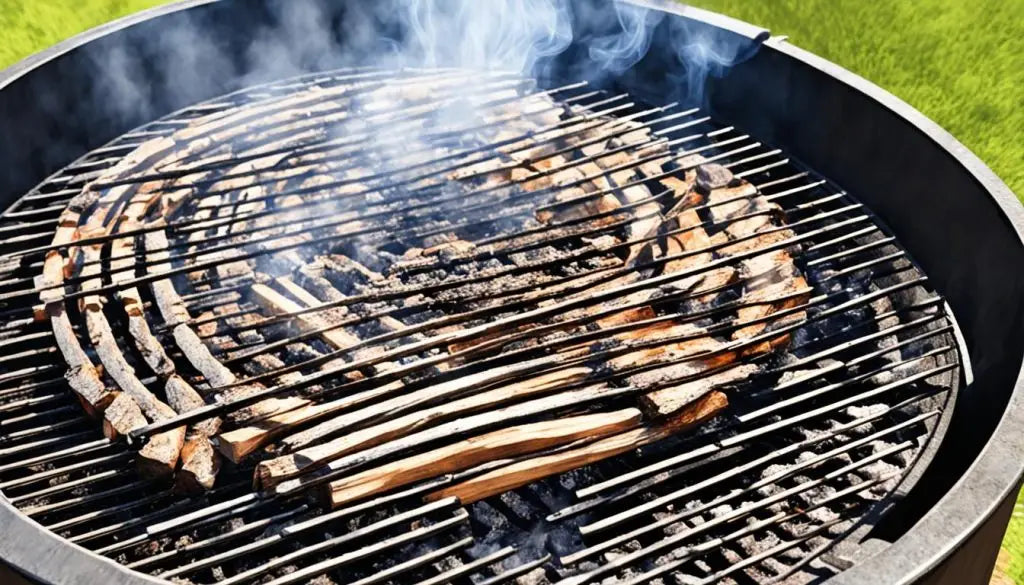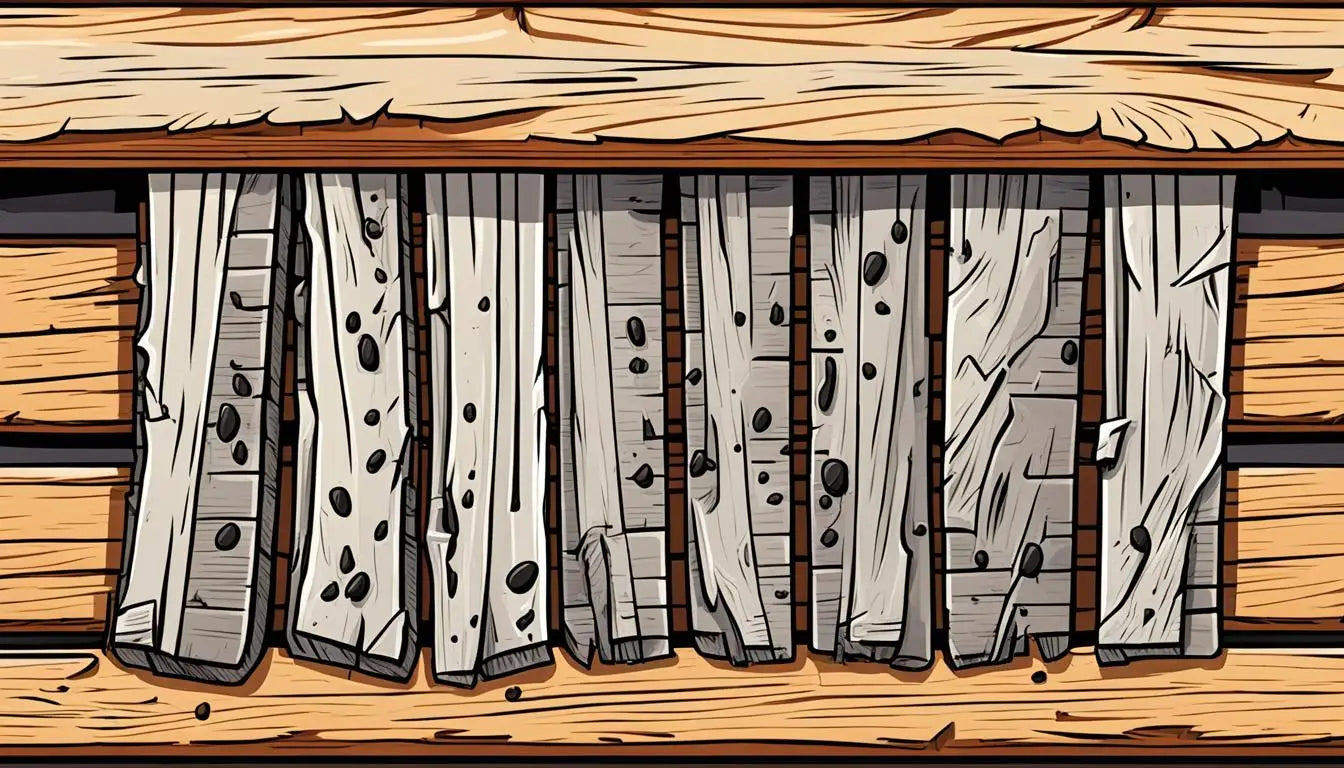"There is no sincerer love than the love of food," George Bernard Shaw once said. What better way to show that love than by mastering a wood BBQ's flame-grilled magic? However, the effects of humidity on wood BBQ can be tricky, often changing how your grill works. In Great Britain, with its changing weather, cooking on a wood BBQ in humid conditions is a puzzle that needs solving.
The impact of moisture on wood BBQ is significant. It can turn a perfect BBQ into a wet mess. But there's no need to worry—knowing about this gives you power. Let's explore how humidity and heat work together, affecting your grill's performance and the delicious results you can achieve.
Understanding the Science of Wood Combustion and Humidity
To really get the best out of a wood BBQ, it helps to know a bit about how wood burns and how moisture plays a part. This understanding highlights how wood changes when it burns. It also shows how moisture impacts this change.
The Four Stages of Wood Combustion
Wood goes through four main stages when it burns. First, it dries out, losing its moisture. Next, it breaks down, releasing gases. Then, these gases catch fire, giving off heat and light. Finally, it turns into charcoal, leaving behind a carbon-rich residue.
How Moisture Content Influences Combustion
The amount of moisture in wood affects how well it burns. Wet or freshly cut wood is hard to burn. The energy meant for heating goes into drying the wood instead. This causes inefficient burning and produces steam and unwanted tastes.
| Wood Type | Moisture Content | Combustion Efficiency |
|---|---|---|
| Green Wood | High (>50%) | Low |
| Air-Dried Wood | Moderate (~20%) | Medium |
| Kiln-Dried Wood | Low ( | High |
The Complexity of Smoke Composition
The smoke from a wood BBQ adds flavour and is quite complex. It varies with the wood's growing conditions, soil, and type. Knowing about smoke helps pick the best wood for your BBQ, depending on the humidity.
To sum up, knowing how wood burns and how moisture affects it helps in controlling the smoke. This leads to a BBQ that's tasty and shows the amazing science behind wood burning.
The Effects of Humidity on Wood BBQ Performance
The joy of British summertime is often marked by the smell of a wood BBQ. However, many don't think about how humidity affects BBQ performance. High humidity makes it hard for air and oxygen to reach the flames. This is needed for a good burn.
Because of this, cooking times may be longer and heat might not spread evenly. Those waiting for a tasty meal might face challenges.

Also, humidity affects how food absorbs smoke and seasonings. This is key to the dish's final taste. With high humidity, it's tough for seasonings to sink into the food. The smoke can't add its usual richness. The result is a change in flavour and texture that may not impress.
BBQ lovers should adjust their methods to suit the British weather. Understanding these challenges helps people prepare. It allows them to host a great BBQ despite the weather.
Can these issues be avoided? Yes. Some suggest drying food before cooking it. Others say watch the BBQ closely to keep performance steady. Following these tips can help avoid disappointment during an unexpected rain.
Maintaining Wood BBQ Efficiency in High Humidity Conditions
Grilling in high humidity poses challenges. It's about keeping a balance to make sure your BBQ stays delicious. With the right knowledge, you can enjoy perfect BBQ days, no matter the humidity.
Choosing the Right Wood: Kiln Dried vs Air Dried
Choosing the right wood is key for good BBQing. Kiln dried wood is best because it burns hotter and more efficiently. This is especially true in damp conditions, unlike air dried wood, which might not burn as well.
Humidity Control Techniques for Optimal BBQ
In damp conditions, humidity control techniques are vital. Use dehumidifiers or keep wood in airtight containers to keep it dry. This ensures your wood is always ready for an efficient BBQ.
Adjusting Air Vents for Better Combustion in Moist Environments
Adjusting air vents is critical for better combustion. It's key in humid weather, helping control burn rate and temperature. Fine-tuning vents leads to more efficient grilling.
| Aspect | Kiln Dried Wood | Air Dried Wood |
|---|---|---|
| Moisture Content | 10-20% | 15-25% |
| Burn Efficiency | High | Variable |
| Suitability for Humidity Control | Excellent | Good |
| Storage Needs | Less stringent | More stringent |
| Cost | Higher | Lower |

In conclusion, improving wood BBQ efficiency in high humidity is challenging but doable. It involves picking the right wood, using humidity control methods, and adjusting air vents right. Following these steps ensures great BBQs, no matter the weather.
Humidity's Influence on Wood BBQ Flavour Profiles
The role of humidity in wood BBQ is crucial for flavour profiles. Moisture in the air mixes with the smoke from different woods. This combination creates unique aromas and tastes. These are signature to the BBQ experience.
The wood used for smoking defines the BBQ's flavour. Each wood type has its own unique essence. For example, hickory from Missouri tastes different from that grown in Louisiana. This shows how wood types and their origins affect flavours.
Impact of Wood Types and Their Origin on Flavour
Knowing about wood and its origin helps a BBQ connoisseur stand out. With humidity important in flavour creation, choosing the right wood is key. Oak, cherry, and apple woods offer distinct textures and scents. They can enhance or balance the BBQ flavour perfectly.
The Role of Water Content in Smoke Aromas
The water content and smoke aromas are closely connected. The humidity level inside the pit changes how smoke flavours the meat. More water in the smoke means a slower flavour infusion. This creates a layer of smoky notes. It's like the subtle flavours at Cambridge's hidden bars, famous for craft beer and Southeast Asian inspired cocktails.
Expert Pitmasters' Techniques for Flavour Maximisation
Pitmasters use varied techniques to maximise flavour. They adjust the pit's humidity to get the perfect flavour in each meat batch. This expertise makes the taste as special as Cambridge's hidden bars. Those bars offer everything from live music to cosy outdoor seating.
Understanding the link between humidity, wood type, and smoke is key to BBQ mastery. It's like exploring Cambridge's hidden bars and their diverse music and food. Wood type and cooking techniques blend to create unforgettable BBQ flavours. They are complex and satisfying.
Conclusion
The impact of humidity on wood-fired BBQ is huge. We've shown why understanding wood combustion and humidity is vital. This is key to making your wood BBQ work its best.
Humidity touches everything in barbecuing. It goes from the wood's fibre to the delicious flavours on your tongue. Knowing how to handle moisture is crucial for BBQ fans.
By using the right wood and mastering humidity control, BBQ lovers can overcome these issues. Adjusting air vents is an art that improves your control over cooking. This makes sure your barbeque works well, even in damp air.
Getting better at grilling is a never-ending path. It's full of learning and new ideas. When you get how humidity affects wood BBQ, making great meals is more likely.
With the right knowledge and skills, anyone can excel at wood BBQ. This is a goal that's possible for those ready to learn and make adjustments. It's about pushing through, no matter the weather, to BBQ greatness.

